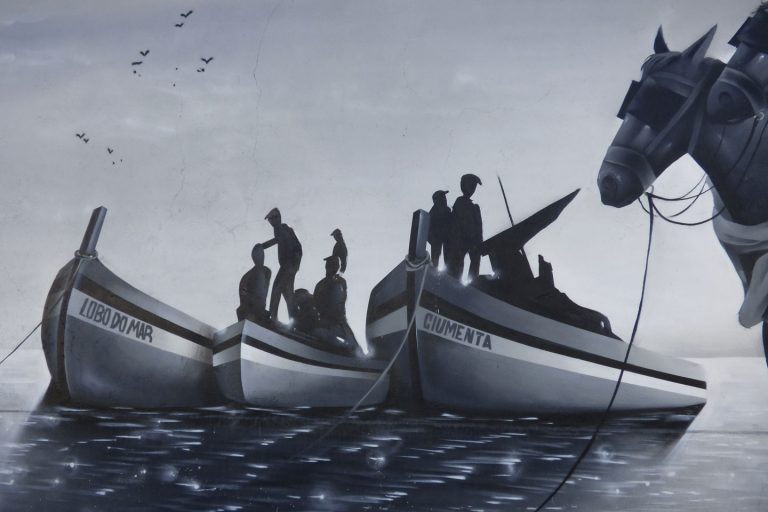Introduction
So what are the best things to see in Olhao?
Well for a small fishing port, there is a fair amount just waiting to be found!
If you’re looking for a bit of culture or something interesting, it’s never far away in Olhao.
There are churches and a museum. There’s a conservatory of music and an auditorium. You’ll also find music, poetry, and film. You’ll find Street Art and Street performers.
In Olhao, events are put on all the time! There are all sorts of options!
Just have a look around – it will be worth it!
Take a look at the Cubist Architecture
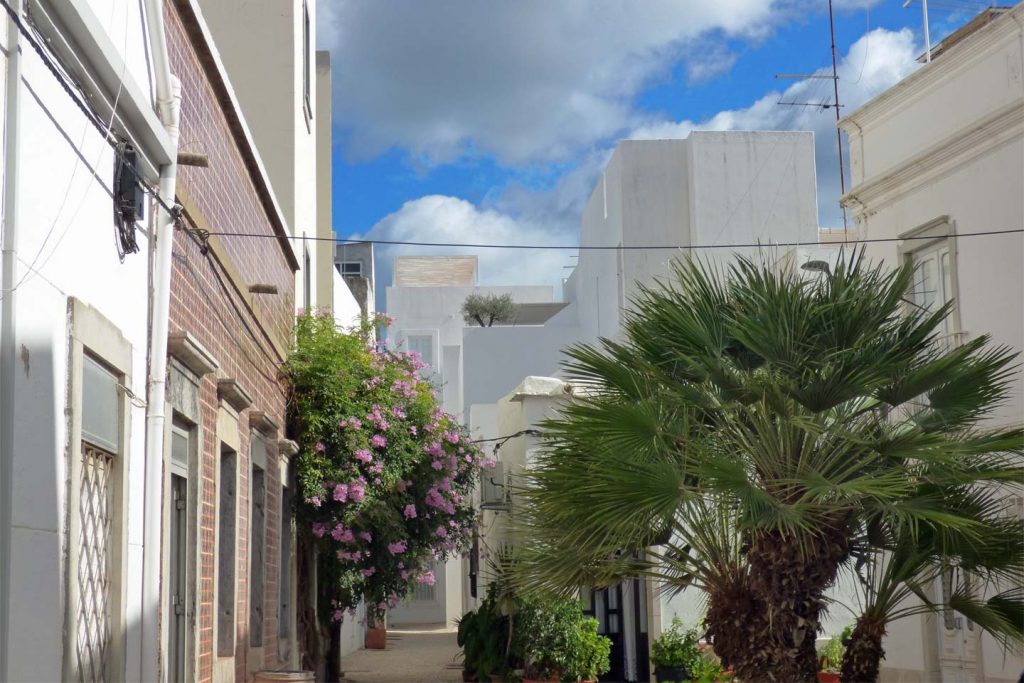
Olhao, well the old part at least, has a distinctly Moroccan flavour.
Just behind the waterfront, you’ll find a sea of white houses, sitting cube-like, with terraces on top. No two are alike. A house may be single-storey or have one or two floors. It may have a balcony or it may not. It may have an external staircase or it may not.
As you walk through the narrow cobbled streets and paths, winding your way between the houses, it all seems chaotic, almost anarchic, and yet calm and peaceful at the same time. It really is a unique place.
If you step 20 yards from one of the main thoroughfares, you’ll find yourself in a different world – a world shaded by narrow streets and palm trees, a world of tranquility, a world where you can find yourself alone with your thoughts and the history of Olhao.
Was this distinct architectural flavour a result of the Moorish occupation?
I think it’s doubtful, since the Moors were driven out of the Algarve at least 500 years before Olhao was even given permission to build houses in stone (see the section on the Bom Sucesso below).
It’s more likely that Olhao’s trade links with Morocco were the cause.
Olhao is the only place (along with Fuseta) on the Algarve where this cubist architecture is so obvious.
But not the whole town is cubist.
It’s not all cubist!
As it grew, Olhao attracted more people. No longer was it simply a town of fishermen. Behind the cubist houses grew a town of merchants and industrialists. They wanted more opulent homes. They wanted to demonstrate their wealth.
Take a stroll along the Avenida da Republica, and some of the streets between there and the port, and you will see a change in Architecture.: bigger houses, taller houses, houses with more balconies, houses with ornate ironwork and tiled frontages.
Some of them are making way for new buildings now, but many are being renovated.
Olhao is a town in a state of flux, but hopefully, its Moorish atmosphere will remain.
See the Church
(Igreja Matriz de Nossa Senhora do Rosário – Our Lady of the Rosary)
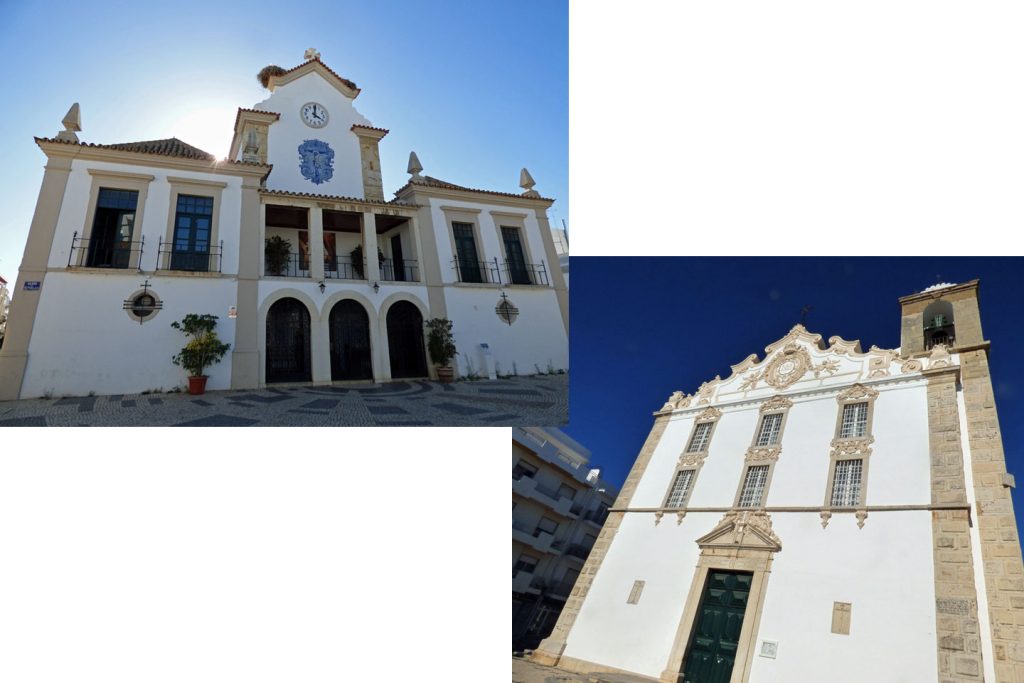
In Olhão, Our Lady of the Rosary is the patron saint, and the Igreja Matriz de Nossa Senhora do Rosário (The Mother Church of our Lady of the Rosary) sits at the bottom end of the Avenida, on the Praça da Restauração.
Its construction was sponsored by the fishing community, beginning in 1698, but only opened to worship in 1715.
Even then the Church wasn’t finished. In 1722, the bell tower was commissioned and the interior of the church wasn’t decorated until after this – a contract for the construction of the altar being agreed in 1726.
On its facade, you can find an inscription that when translated reads: “At the expense of the ‘sea men of this people’ made this new temple, when there were only a few huts”.
The bell tower provides a great view over the cubist houses below.
Inside there are five altars, with the chancel having a stunning golden carved altarpiece and triumphal arch. On the ceiling is a fresco and an image of Our Lady of the Rosary.
At the back of the church is the chapel of Nossa Senhora dos Aflitos (Our Lady of the Afflicted). It’s very unusual in that you can see it from the Avenida da Republica through wrought iron gates and railings. In a sense, it’s open to the elements with a statue of Christ on the wall.
It is here that traditionally, fishermen’s wives have to come to pray for the safe return of their loved ones.
Peruse the Museum
Casa do Compromisso Marítimo/Museu da Cidade de Olhão
(The House of the Maritime Commitment/The Museum of the City of Olhao)
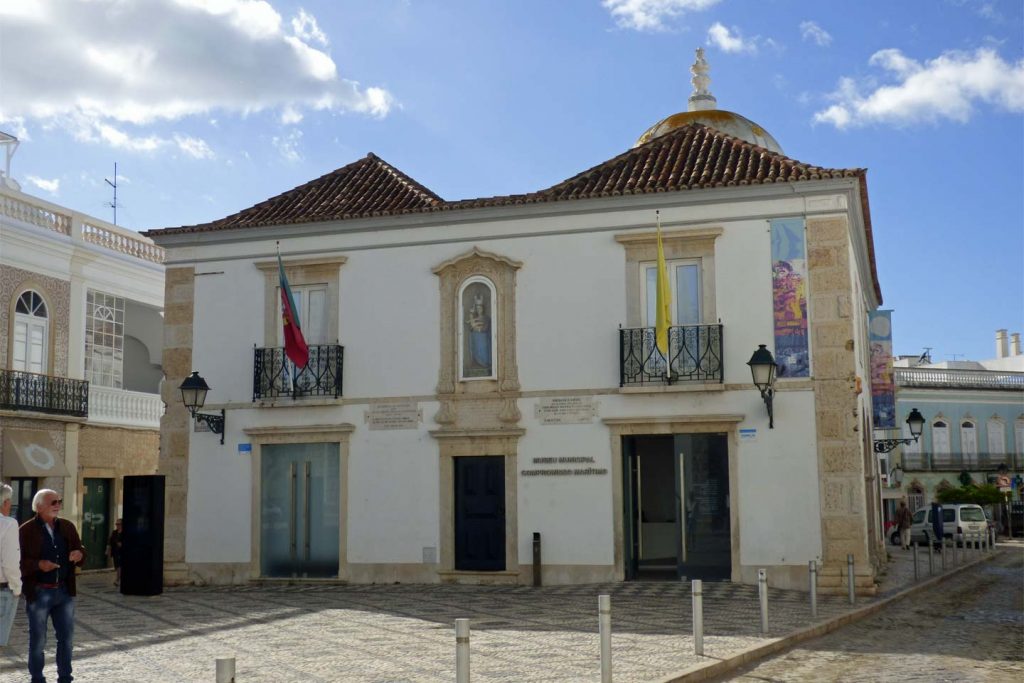
The Compromisso Marítimo (the Maritime Commitment, or the Royal Brotherhood of the Holy Body of the Mariners) was formed in 1765, a fishermen’s association that mainly aimed to provide social assistance to fishermen and their families.
In 1771, the Casa do Compromisso Marítimo was opened on the Praça da Restauração – opposite the Igreja Matriz – as their headquarters.
More recently, it has become the Olhao Museum, with three themes so I’ve been told: archaeology, the history of Olhao, and fishing. It exists to promote the town’s cultural heritage.
Some of its exhibits change on a regular basis, so it’s a place that you can visit time and again.
What fascinated me on my last visit was a pictorial history of Olhao on the square between the Museum and the Church. At the time of writing, there’s more of this on the Avenida too.
In particular, the photo of people massing on the square demonstrating during the ‘Carnation Revolution’ of 1974 is particularly evocative.
The Museum is well worth visiting.
Website: Museu Municipal
See the Igreja de Nossa Senhora da Soledade
(The Church of Our Lady of Solitude)
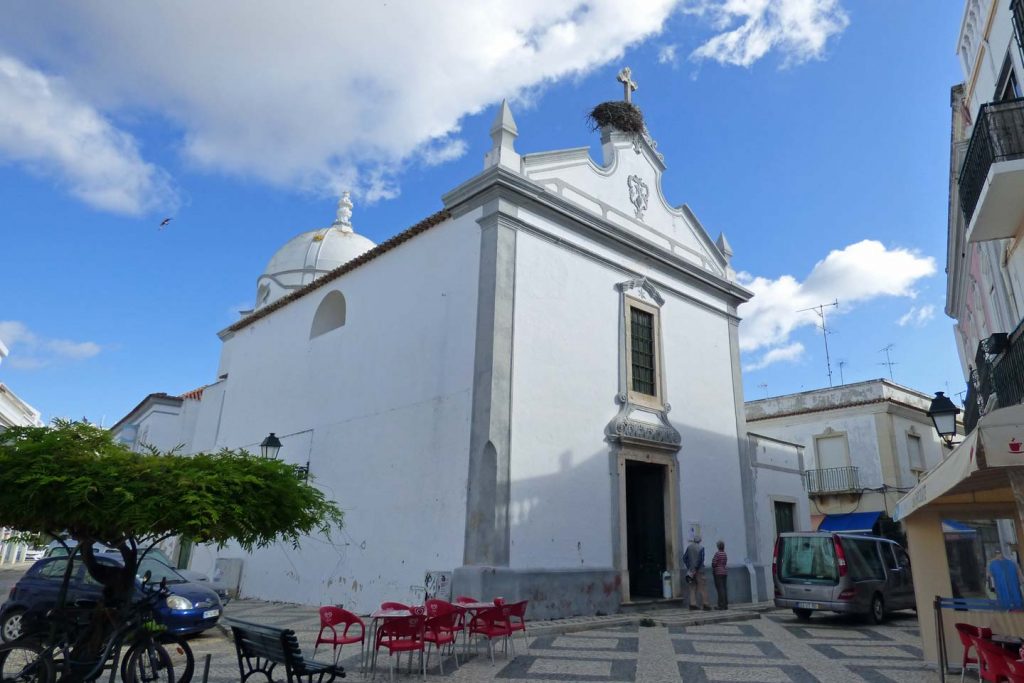
This small Church sits just behind the museum, and underwent major changes following the 1755 earthquake, and again in 2004 when it was renovated.
It has some unusual features:
| It has a large dome, very simple, very plain. |
| In its entrance, there is a well, covered with a stone slab |
| A Stork’s nest sits on the roof above the door |
| Services are no longer held here |
| The locals often refer to it as the Church of the Dead – since it is now used as a funeral chapel |
You often see gatherings of people at Cafe Chocolate opposite, people who have come to pay their respects, both to the body of the deceased, and to the family of the person who has died.
It’s worth a visit, if only to sit at the Cafe Chocolate to have a coffee and watch the world go by.
See the ‘Bom Sucesso’
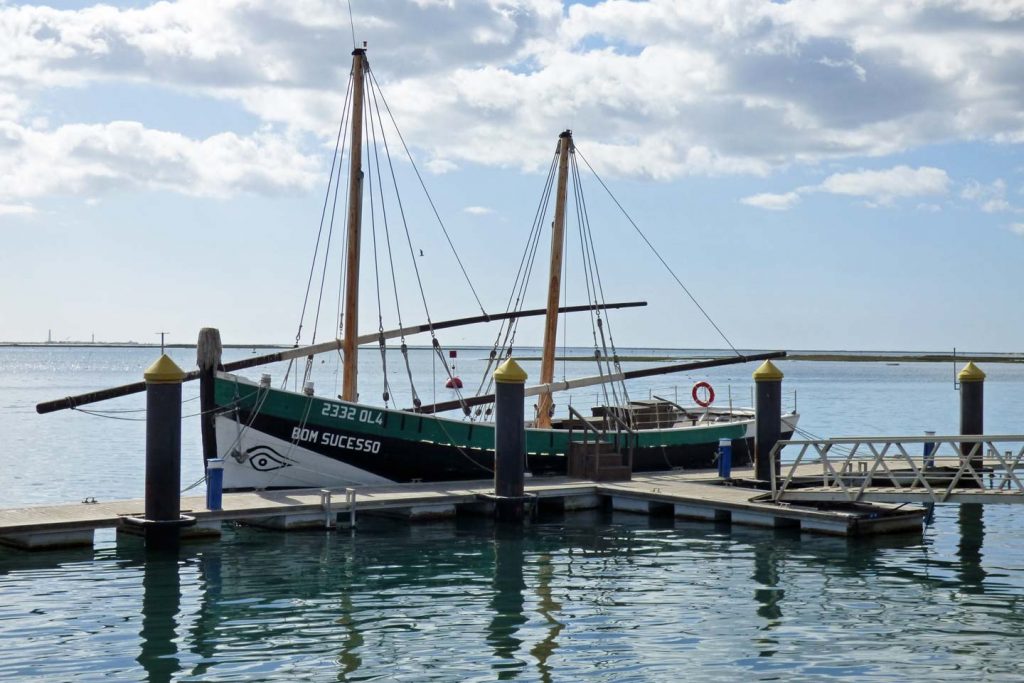
In the early 1800s, the French-controlled the Iberian Peninsula, but the locals of Olhao, being the stubborn lot that they are, decided that they’d had enough. They began the insurrection that drove the French out of the Algarve.
They then decided that it would be a good idea to let Joao VI, King of Portugal know what had happened, since he was living in exile in Brazil. They wanted to tell him that it was now safe to return to Portugal.
So they set sail from Olhao, in a tiny boat, a replica of which you can see down on the waterfront by the Mercado – ‘O Caíque de Bom Sucesso’.
With only basic maps and the stars for navigation, they made it to Brazil and conveyed the news to the Royal family. The King didn’t actually return until 1821, but as a reward for their bravery, a Royal Charter was granted.
Olhao was proclaimed a Town (no longer part of Faro) with the formal name of ‘Vila do Olhão da Restauração’. One result of this was that they were now allowed to build houses in stone!
The original ‘Bom Sucesso’ played a huge part in making Olhao what it is today. It’s worth a look at the replica if only to imagine what it must have been like to sail across the Atlantic in that vessel.
Brave men.
See the Xmas lights
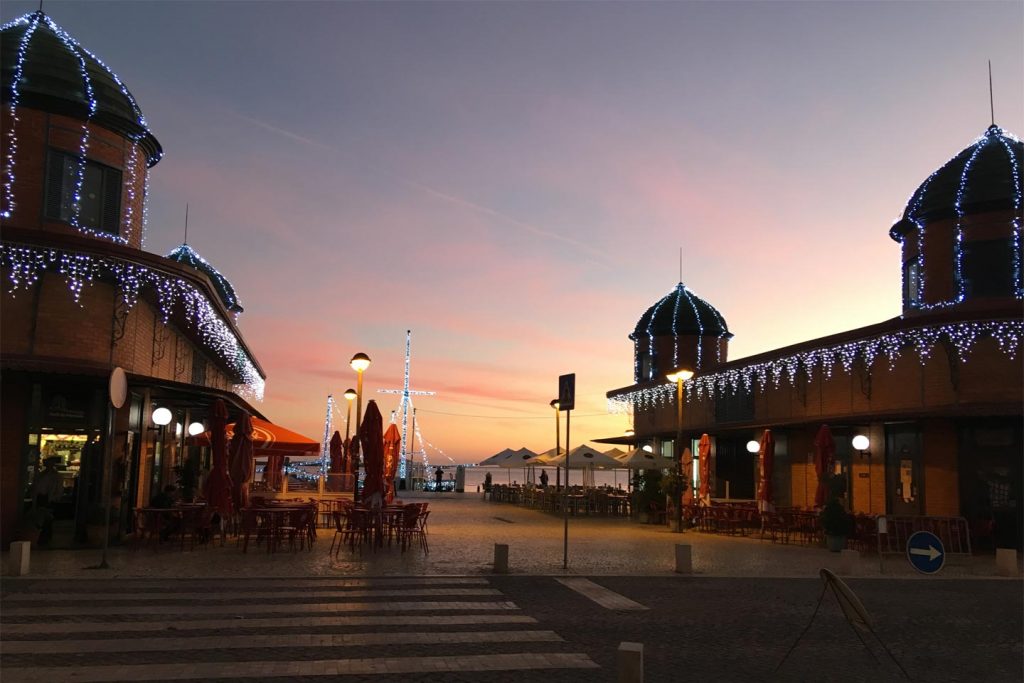
When you think of the Algarve, you think of hot summers, blue skies, lazing on the beach, swimming in the sea.
You don’t tend to think of the Algarve at Christmas.
But if you get the chance, you should visit Olhao at this time of year. It’s wonderful. And the Christmas lights provide a very different sort of atmosphere to what you’d expect on the Algarve.
The Bom Sucesso is lit up, almost like a Christmas tree; there are lights stretched across the narrow alleyways; the trees along the Avenida da Republica are covered in lights.
It really is a fairytale Christmas atmosphere in Olhao.
See the Mural near Pingo Doce
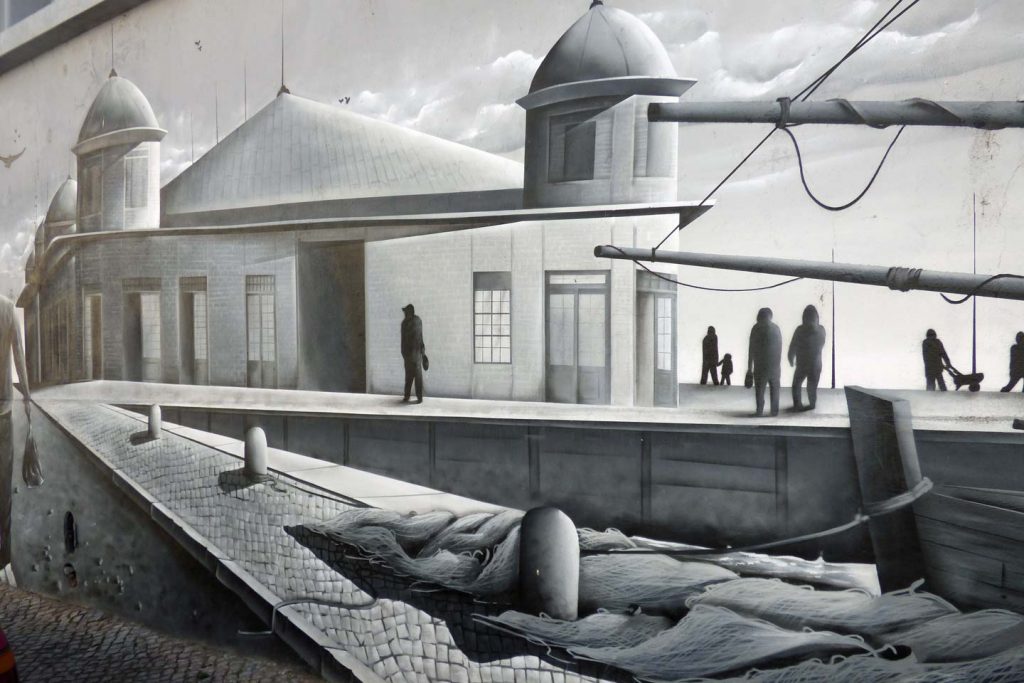
Do you know where Pingo Doce (supermarket) is in Olhao? The one closest to the ferries?
If you head towards here, you’ll come across the most fantastic mural along the walls of the Rua da Fabrica Velha – the street of the old factory.
The mural has no colour – it’s just black, white and grey – which seems to me to be in keeping with this town. At first glance it looks drab, but when you look a little closer? It’s stunning!
The mural is about Olhao. A reminder of how things were done in the past, of the soul of this town.
It shows fishermen at work, their wives cleaning the fish, the harbour, horse-drawn wagons, the market… It really is an amazing piece of work. You can spend a lot of time here looking at all the amazing details.
What amazes me more though, is that everybody seems to walk past it without a second glance.
It’s definitely worth more than a second glance.
if you want to see more images, click here.
See the Graffiti
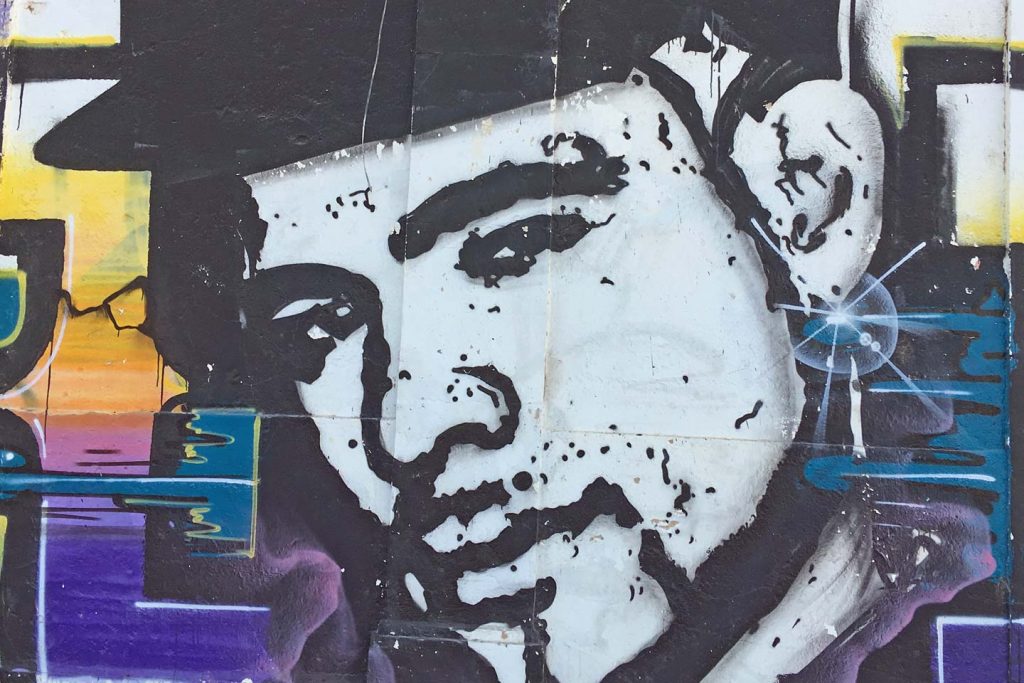
I’m not sure what you think about Graffiti. Many people hate it and think it ruins the look of a town.
This is certainly what I used to think – and then I came to Olhao.
You can’t miss the Graffiti here, and in fact, the more you look, the more you see.
At first, I was shocked, and then slowly, I began to look at it more closely. And now? It’s no longer Graffiti to me: it’s Street Art!
Olhao Street Art!
For a long time, Olhao was poor: a very poor town, rundown, infested with crime. There was no pride. Houses stood in ruins, nothing worked.
In such an environment, with a disaffected youth population, there is no surprise that Street Art became the norm.
But what is surprising is the quality of some of this Street Art.
Take a walk or a drive up to Vivenda Vitoria on the EN125. It’s an old villa that was donated to the town to be set up as an art gallery, I believe. That never happened for whatever reason, and so now it has become a canvas. Every inch of this building has been covered with Art. Quite something when you examine it properly!
Throughout the town, you’ll see tags, cartoon characters (Spongebob Square Pants, Porky Pig, Goofy, Bart Simpson…), historical characters (Red Indians, Che Guevara…), faces, abstract images, tales of the sea.
It is a most fantastic, eclectic mix of styles and images.
Sen (Dário) and Bean (Sergio) – together known as Blubla – produce most of this work. The local police accept them, but it’s not always the case elsewhere.
Like I said, you either like Graffiti/Street Art or you don’t.
If you want to see some more of these works of art, click here.

